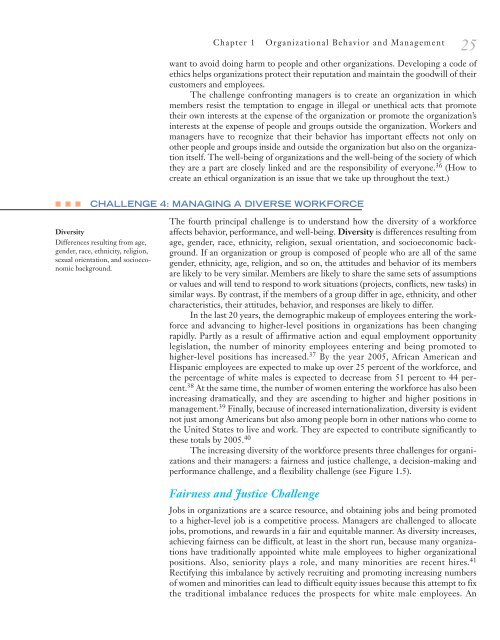chapter - Pearson
chapter - Pearson
chapter - Pearson
Create successful ePaper yourself
Turn your PDF publications into a flip-book with our unique Google optimized e-Paper software.
Chapter 1<br />
Organizational Behavior and Management<br />
25<br />
want to avoid doing harm to people and other organizations. Developing a code of<br />
ethics helps organizations protect their reputation and maintain the goodwill of their<br />
customers and employees.<br />
The challenge confronting managers is to create an organization in which<br />
members resist the temptation to engage in illegal or unethical acts that promote<br />
their own interests at the expense of the organization or promote the organization’s<br />
interests at the expense of people and groups outside the organization. Workers and<br />
managers have to recognize that their behavior has important effects not only on<br />
other people and groups inside and outside the organization but also on the organization<br />
itself. The well-being of organizations and the well-being of the society of which<br />
they are a part are closely linked and are the responsibility of everyone. 36 (How to<br />
create an ethical organization is an issue that we take up throughout the text.)<br />
■ ■ ■<br />
CHALLENGE 4: MANAGING A DIVERSE WORKFORCE<br />
Diversity<br />
Differences resulting from age,<br />
gender, race, ethnicity, religion,<br />
sexual orientation, and socioeconomic<br />
background.<br />
The fourth principal challenge is to understand how the diversity of a workforce<br />
affects behavior, performance, and well-being. Diversity is differences resulting from<br />
age, gender, race, ethnicity, religion, sexual orientation, and socioeconomic background.<br />
If an organization or group is composed of people who are all of the same<br />
gender, ethnicity, age, religion, and so on, the attitudes and behavior of its members<br />
are likely to be very similar. Members are likely to share the same sets of assumptions<br />
or values and will tend to respond to work situations (projects, conflicts, new tasks) in<br />
similar ways. By contrast, if the members of a group differ in age, ethnicity, and other<br />
characteristics, their attitudes, behavior, and responses are likely to differ.<br />
In the last 20 years, the demographic makeup of employees entering the workforce<br />
and advancing to higher-level positions in organizations has been changing<br />
rapidly. Partly as a result of affirmative action and equal employment opportunity<br />
legislation, the number of minority employees entering and being promoted to<br />
higher-level positions has increased. 37 By the year 2005, African American and<br />
Hispanic employees are expected to make up over 25 percent of the workforce, and<br />
the percentage of white males is expected to decrease from 51 percent to 44 percent.<br />
38 At the same time, the number of women entering the workforce has also been<br />
increasing dramatically, and they are ascending to higher and higher positions in<br />
management. 39 Finally, because of increased internationalization, diversity is evident<br />
not just among Americans but also among people born in other nations who come to<br />
the United States to live and work. They are expected to contribute significantly to<br />
these totals by 2005. 40<br />
The increasing diversity of the workforce presents three challenges for organizations<br />
and their managers: a fairness and justice challenge, a decision-making and<br />
performance challenge, and a flexibility challenge (see Figure 1.5).<br />
Fairness and Justice Challenge<br />
Jobs in organizations are a scarce resource, and obtaining jobs and being promoted<br />
to a higher-level job is a competitive process. Managers are challenged to allocate<br />
jobs, promotions, and rewards in a fair and equitable manner. As diversity increases,<br />
achieving fairness can be difficult, at least in the short run, because many organizations<br />
have traditionally appointed white male employees to higher organizational<br />
positions. Also, seniority plays a role, and many minorities are recent hires. 41<br />
Rectifying this imbalance by actively recruiting and promoting increasing numbers<br />
of women and minorities can lead to difficult equity issues because this attempt to fix<br />
the traditional imbalance reduces the prospects for white male employees. An

















